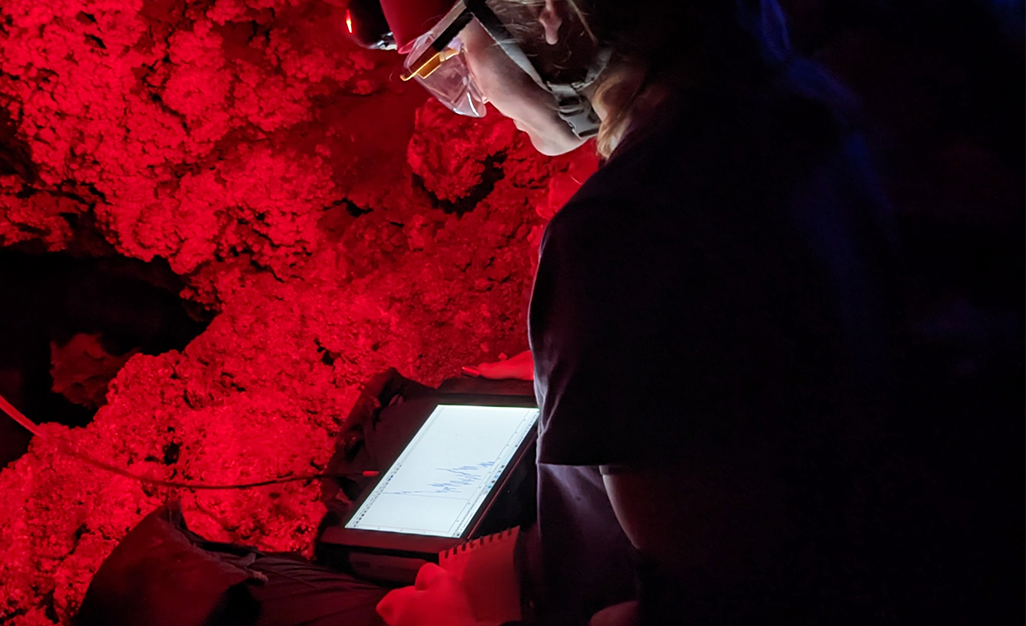Taking field science underground
Taking field science underground

There’s a common misconception that science is a solitary act, one that only happens sitting inside of a lab. But Josh Sebree, associate professor of astrochemistry and astrobiology at UNI, is on a mission to show his students that that couldn’t be further from the truth.
For the past several years, Sebree has led an ongoing field research project that aims to discover how the minerals and microorganisms found in extreme environments (like cave systems) could help scientists understand how life might survive on other planets.
To do this, Sebree and his students don their caving gear and climb down to the dark depths of various cave systems in the name of science.
The project began in 2019, when Sebree led the first group of UNI students to Wind Cave National Park in South Dakota to analyze organics, waters and minerals found there.
As one of the longest and most complex cave systems in the world, Wind Cave remains mostly unexplored. This means much of the ecosystem down there has remained untouched for more than 10,000 years – offering a unique look at how extreme life can form and survive in the most unlikely of places.
The students were among the first researchers to analyze samples in the cave, and in some cases, were among the few humans to reach certain parts of the cave.
The experience, as much as the research itself, has been eye-opening for many students, Sebree said.
“You could tell right away that some of them were hooked,” he said. “You can see the way it impacts them. They come up from the cave as a whole new person. It builds a lot of confidence, and really opens their eyes to exciting opportunities out there in the field.”

Since then, the popularity of the project has only grown. Across more than a dozen trips, over sixty UNI students have now made the trek to Wind Cave.
More recently, though, Sebree expanded the project to include sampling from Coldwater Cave near Decorah, Iowa.
The first student trip to Coldwater Cave took place in the summer of 2022, and Sebree has been bringing students there since – with about one trip a month to Coldwater Cave year round, on top of several trips to Wind Cave throughout the summer of 2023.
Jacqueline Heggen, a biochemistry and biology major going into her junior year, first heard about the cave research while working as a lab assistant for Sebree.
“He would talk about the caves and the research going on there, and eventually, I decided to get involved,” she said. “My first experience caving was going to Coldwater in November of 2022. From there, I got hooked. I’ve been on several trips now, with more planned for this summer. From my first moment in the cave, looking around, I realized this was not in the game plan. I never thought I would be doing this. But now, I’m just planning out how I can get to the caves more. Last week I was underground for 30 hours. I can’t get enough.”
So far, the research at Coldwater Caves is still ramping up. Sebree is working to get additional grant funding to buy waterproof equipment for his students to better sample inside the cave. But the team has already collected water samples from certain parts of the cave, which they have brought back to the labs on campus for analysis.
The hope is to eventually sample water from the various tributaries throughout the cave, and establish a more complete idea of the types of microorganisms and minerals that affect the different environments in the cave – similar to the work being done at Wind Cave.
Sebree says he’s excited to add Coldwater Cave to the research project, giving students a look at two very different biospheres.
On one hand, you have Coldwater Cave, which is essentially an underground river that flows through the 17-mile stretch of cave system. Because water is constantly flowing in from ground water and agricultural runoff, it is very nutrient-rich. The water is constantly emptying and refilling itself, meaning that the water is only a couple of days old at any given time.
On the other hand, you have Wind Cave, which is home to stagnant lakes of groundwater collected deep below the surface. Because the water takes thousands of years to reach the lakes, some of the water there is more than 30,000 years old. Through the intense process of traveling below the surface with very little food, the microbes that live in that water become highly evolved to survive on trace nutrients.
“The idea of looking at these two very different biospheres is because we want to look at all kinds of options for what life could be like on other planets,” Sebree said. “Icy moons that look like frozen oceans could potentially be very nutrient poor. Other moons are surrounded by gasses like methane, which may rain really nutrient-rich liquid organics onto the surface.”
The way that life survives in these hostile, nutrient-dense and nutrient-poor cave environments could be the key to discovering whether (and how) life exists in hostile environments on other planets.
This idea is demonstrated back in the labs on campus, where one of Heggen’s current tasks this summer involves creating cryogenic ice balls with some of the water collected from Coldwater Cave.
Using liquid nitrogen to freeze the water to the same temperature as an icy moon, the team will be able to see the properties from trapped organics – the same as what satellites may one day see on an icy moon.
For the students involved in the research, it’s the experience of a lifetime.
“It’s so exciting to be a part of this, and it’s such an eye-opening experience,” Heggen said. “Going into college I was one of the people who thought science was just sitting in a lab. But this project lets us go out into the field, collect samples, and bring them back to study. Now that I have this experience, it’s shown me what I can do, and what I’m capable of. If nothing else, it’s really grown my confidence in myself.”


For Sebree, the experience is just as rewarding.
“I first got introduced to the idea of field chemistry at UNI, by my colleague Alexa Sedlacek, doing carbonate stuff at quarries,” he said. “Normally, field research is reserved for Earth science or biology majors, but it really opened my eyes to the fact that chemists can do field research, too. I didn’t find out about this stuff until I was in my thirties, and I fell in love with it. So for an eighteen or nineteen year old, to be able to find out about these experiences earlier can totally change what they might think about life and their career, and what’s possible for them. I would much prefer my students to have this experience early on. Plus, it’s really fun to provide a different flavor of science and research.”
Going forward, work will continue at both Wind Cave and Coldwater Cave.
Sebree has several years left in a multi-year grant from the Iowa Space Grant Consortium to study Wind Cave, and he’s working on securing grant funding to build the research being done at Coldwater Cave.
As the two projects continue to grow and gain traction, Sebree is looking forward to bringing more UNI students on board.
“Our collaboration keeps growing across campus,” he said. “We’ve got students from chemistry and biochemistry, biology and earth science collecting and analyzing samples, we’ve got digital media students filming the trips for documentary-style videos, and we’ve just brought in students from athletic training and kinesiology who are going to study the physical and physiology effects of caving. It’s a really unique, multidisciplinary project that has resulted in so many positive experiences for students here. It’s something completely unique to UNI, and I’m very proud of that.”




